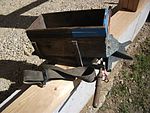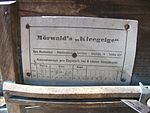Clover violin
A clover violin is an ancient-looking device for sowing seeds, which is still occasionally used today as a sowing aid or for spreading granules on smaller cultivated areas. The seed fiddle came to Western Europe from the United States around 1850. In Germany, the first clover violin was presented at the "Exhibition of German Industrial and Commercial Products in Munich 1854".
The clover violin is a handy, manually operated device whose exterior is reminiscent of the body of a violin . It is worn on the side of the body with a shoulder strap; by pulling and pushing a built-in stick, the tendon (cord) moves the spreading disc and spreads the spreading material. Spreading width, spread rate and sowing rate are usually adjustable. The clover violet ensures that fine seeds are sown evenly and is often used for clover (hence its name), rape or other small seeds, as well as weed killers and other granulates.
After the fine seeds have been sown, the area is harrowed or leveled and rolled because these seeds need good ground contact. The clover violin is not suitable for seed mixtures with very different grain weights and sizes, as the seeds would be separated by centrifugal force when they are spread.


